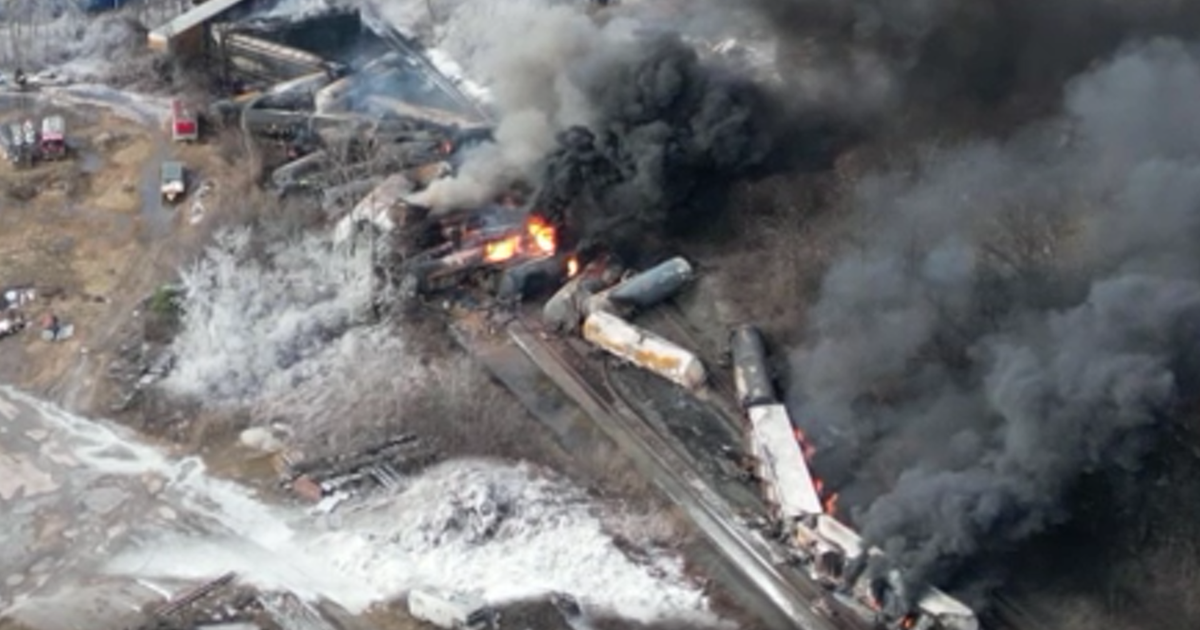Ohio Train Disaster: Prolonged Presence Of Toxic Chemicals In Nearby Structures

Table of Contents
The derailment involved the release of a multitude of hazardous materials, including vinyl chloride, butyl acrylate, and ethylhexyl acrylate. The immediate response included controlled burns to mitigate the risk of a larger explosion, but this action released toxic fumes into the air and potentially contaminated the surrounding soil and water. This article will focus on the ongoing threat posed by the lingering presence of these chemicals in and around affected structures and the broader environmental impact.
Persistence of Vinyl Chloride and other Toxic Chemicals
Vinyl chloride, a known carcinogen, is particularly concerning due to its persistence in the environment. Its volatile nature allows it to spread easily through air, while its ability to adhere to soil particles and infiltrate groundwater necessitates long-term monitoring and remediation efforts. Other released chemicals, such as butyl acrylate, also pose significant risks. These substances can leach into soil, groundwater, and building materials, lingering for extended periods.
- Porous building materials, such as wood, concrete, and insulation, can absorb and retain significant amounts of these chemicals.
- The half-life of vinyl chloride in soil and water varies depending on factors like temperature and soil composition, but it can persist for months, even years, posing a continued threat.
- Numerous studies of past industrial accidents and chemical spills show the long-term persistence of similar chemicals in the environment, highlighting the need for proactive and sustained remediation efforts following the Ohio train disaster.
Health Concerns for Residents Near the Derailment Site
Prolonged exposure to even low levels of vinyl chloride and other released toxins presents significant health risks to residents in the vicinity of the derailment. The potential long-term effects are particularly troubling.
- Respiratory problems: Irritation, inflammation, and even chronic respiratory diseases are possible consequences.
- Increased cancer risk: Vinyl chloride is a known human carcinogen, significantly increasing the risk of various cancers.
- Neurological effects: Exposure to these chemicals can negatively impact the nervous system, leading to headaches, dizziness, and cognitive impairment.
- Reproductive issues: Studies have linked exposure to certain chemicals released in the derailment to reproductive problems.
- Ongoing health monitoring and screenings are crucial for affected populations to identify and address health issues promptly. The long-term effects may not be immediately apparent, emphasizing the importance of continued medical surveillance.
Contamination of Homes and Businesses
The contamination extends beyond the immediate vicinity of the derailment site. Homes and businesses near the tracks may be contaminated through various pathways:
- Air contamination: Toxic fumes can permeate building structures, leaving behind chemical residues.
- Water contamination: Groundwater contamination poses a serious threat to drinking water supplies, potentially affecting well water in the area.
- Soil contamination: Contaminated soil can track into homes and businesses, further exacerbating the problem.
Decontamination and remediation present significant challenges. The cost of cleaning up contaminated properties is substantial, and identifying all affected structures remains a complex undertaking. The extent of the damage varies greatly depending on factors like proximity to the derailment and building materials.
Environmental Impact and Long-Term Remediation
The ecological implications of the Ohio train disaster extend far beyond the immediate area. Long-term remediation efforts are crucial to address the widespread contamination.
- Long-term monitoring of water sources: Regular testing of wells, rivers, and other water bodies is vital to assess the extent and spread of contamination.
- Soil testing and remediation: Extensive soil testing is needed to identify contaminated areas, followed by appropriate remediation strategies, which may include excavation and disposal of contaminated soil.
- Air quality monitoring and mitigation: Continued air quality monitoring is essential to track the dispersion of any lingering pollutants.
- Government agencies and private companies have a crucial role to play in the cleanup, requiring coordinated and sustained efforts. The long-term costs associated with remediation will be substantial, requiring both public and private investment.
Conclusion
The Ohio train disaster is far from over. The prolonged presence of toxic chemicals in nearby structures and the environment poses significant long-term health and environmental risks. The potential for long-term health problems, the challenges of comprehensive cleanup, and the broader ecological impact necessitate sustained attention and action. We must stay informed about the ongoing situation, support affected communities, and demand accountability from responsible parties regarding the Ohio train derailment cleanup. Contact your representatives, support organizations working on remediation and support for affected residents, and stay vigilant about the long-term effects of the Ohio train disaster and Ohio train disaster health concerns. The future health and well-being of the community depend on our collective commitment to addressing this ongoing crisis.

Featured Posts
-
 Martin Compston And Brendan Rodgers Star In New Celtic Fc Advert
May 06, 2025
Martin Compston And Brendan Rodgers Star In New Celtic Fc Advert
May 06, 2025 -
 Knicks Vs Celtics Prediction Game 1 Playoffs Best Bets And Picks
May 06, 2025
Knicks Vs Celtics Prediction Game 1 Playoffs Best Bets And Picks
May 06, 2025 -
 The Ultimate Sabrina Carpenter Fortnite Guide Outfits Emotes And More
May 06, 2025
The Ultimate Sabrina Carpenter Fortnite Guide Outfits Emotes And More
May 06, 2025 -
 Mindy Kalings Weight Loss Journey Before And After Photos
May 06, 2025
Mindy Kalings Weight Loss Journey Before And After Photos
May 06, 2025 -
 San Antonio Spurs Facing Coaching Uncertainty After Popovich News
May 06, 2025
San Antonio Spurs Facing Coaching Uncertainty After Popovich News
May 06, 2025
